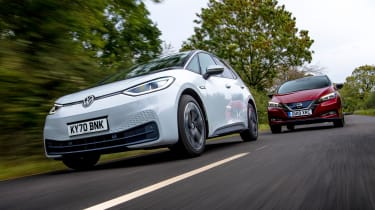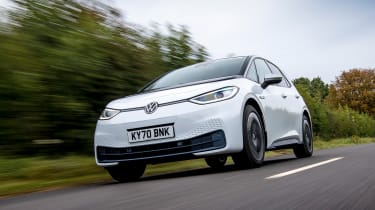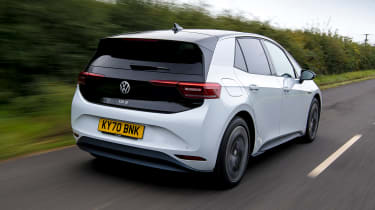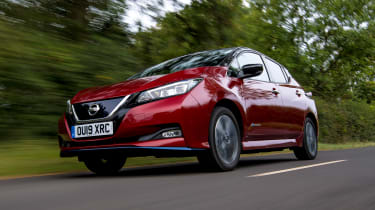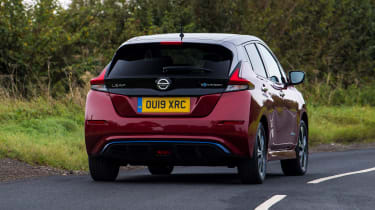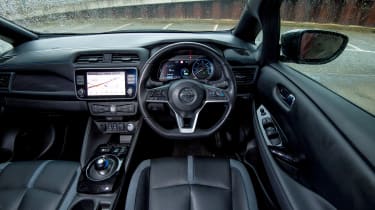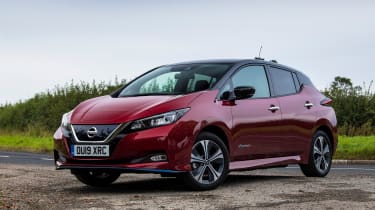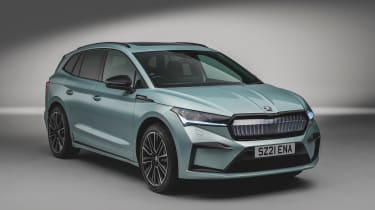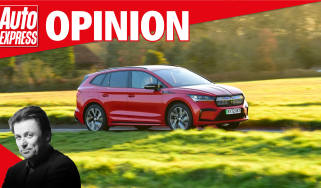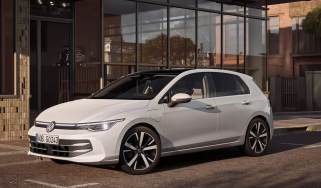Volkswagen ID.3 vs Nissan Leaf
The Nissan Leaf has been one of the best-selling electric cars of the past decade - we find out if it'll be able to fend off the hot anticipated Volkswagen ID.3
When Volkswagen goes electric, you know what has been an emerging trend for years is turning towards mainstream motoring.
The VW Group was a big player in popularising the switch to diesel more than a decade ago with its family cars. But it was ultimately undone by its own less-than-auspicious approach to emissions claims, and the resulting dieselgate scandal forced VW down the road of electrification earlier than it might have planned. So we now have the ID.3, the firm’s first bespoke battery-electric family car.
Of course, we’ve tried and tested the previous-generation Volkswagen Golf in electric form, but this new hatchback doesn’t share its architecture with any combustion-engined vehicle in the German manufacturer’s line-up.
That’s much the same as the Nissan Leaf. The Leaf family hatchback pioneered affordable electric motoring when it was launched and is now in its second generation.
The Leaf is slightly pricier than the ID.3, but has less range. However, despite these small differences, both models are going after the same buyer – so will it be Volkswagen’s new contender that wins here, or is it too late to the party to beat the Nissan Leaf?
Volkswagen ID.3
| Model: | Volkswagen ID.3 1st Edition |
| Price: | £35,880 |
| Powertrain: | 1 x e-motor/lithium-ion battery, 201bhp |
| 0-62mph: | 7.3 seconds |
| Test economy: | 3.5 miles/kWh |
| CO2: | 0g/km |
| Annual road tax: | £0 |
The ID.3 is a massive car for Volkswagen, symbolising a new era for the brand with a fresh form of propulsion. The £35,880 (after the £3,000 UK Plug-in Car Grant) 1st Edition is our initial opportunity to try the car in the UK.
Design & engineering
It’s no secret that VW has had some teething problems in getting the ID.3 to market, but given it’s such an important car for the manufacturer, signalling the start of a new era for Volkswagen, there is nowhere to hide with this, its first model in the ID line-up.
It’s a bespoke electric vehicle and as such is the first car we’ve tried that is based on the VW Group’s MEB architecture for electric cars. Think of it like the Group’s MQB technology, but the MEB platform only takes batteries and electric motors. This does give it great flexibility, though.
The ID.3 is available with many different battery and motor combinations, but for this 1st Edition car – currently the only model that’s been delivered to UK buyers – you get a 62kWh battery, of which 58kWh is usable, supplying a rear-mounted electric motor that produces 201bhp and 310Nm of torque. These figures are more than you get with most conventional family cars, while the battery has a claimed 260-mile range, 21 miles more than the Leaf.
The car’s construction is relatively standard, though. It’s made out of steel and uses MacPherson- strut front suspension and a multi-link rear layout. Like many EVs, including the Leaf, the ID.3 packages its battery in the floor of the car, so while it weighs 1,719kg, relatively heavy for a family hatchback, at least that mass is kept low.
As with its combustion-engined Golf sibling, the focus has been placed on digital technology, and it goes hand in hand with an EV like the ID.3.
As in the Golf, you get a 10-inch touchscreen multimedia set-up and a digital dash, but the cabin is more minimalist than conventional family hatch rivals. Think more Tesla, whereas the Leaf is more like a traditional petrol or diesel-engined car inside.
Quality is okay, with some cool colour inserts for the dash, even if the plastics are a little tough for the money in places, but the layout of the interior is what makes the ID.3 feel modern compared with the more conventional-feeling and looking Nissan EV.
Driving
Despite its weight, those power and torque figures mean a 0-62mph time of 7.3 seconds, which is surprisingly quick. But we know by now that EVs deliver their performance in a much more urgent and immediate way than a regular petrol or diesel car, because an EV’s torque hits the moment you push the pedal.
It’s even more impressive from a standstill to 30mph in town, where that torque really tells. Of course, there’s no engine noise, and the whine from the rear-mounted motor is barely audible, so the ID is nicely refined as well.
Both cars are quiet on the move, but the VW’s suspension doesn’t clonk over broken roads like the Leaf’s does, while at high speed on the motorway wind noise is much better suppressed in the German machine. That lack of suspension noise is accompanied by a much smoother reaction to bumps. Harsh imperfections still overwhelm the dampers, but on most roads and over most surfaces the ID.3 has a calm and composed ride, even on 19-inch wheels, so it’s a refined family car that mixes maturity and performance with solid handling, security and ease of driving.
Practicality
On the charging front, the Volkswagen outclasses the Nissan, but in other areas the Leaf claws back ground.
The ID.3’s boot is 385 litres – just four litres larger than a Golf’s, despite not having an engine and fuel tank. The Leaf offers 420 litres, but, as with the Golf, the ID’s luggage volume is just enough for a family.
VW’s newcomer is also a full five-seater and, with no central tunnel, legroom in the rear for middle-seat passengers is better than usual. The packaging is good; there’s more leg and headroom than in the Nissan, as well as the ID’s Golf family car sibling. The relatively sparse cabin provides many extra storage options over the more cramped-feeling Leaf, too.
Ownership
VW might have scored a relatively poor 19th place out of 30 brands in our Driver Power 2020 satisfaction survey, but many of those results were based on owners’ reactions to the company’s ICE cars, not its EVs.
As a result, take its scores for the mpg and running costs, and reliability and build, with a pinch of salt. This ID.3 is a little different in this respect. But still, VW was eight places behind Nissan.
At least the ID.3 1st Edition gets plenty of safety kit, including autonomous braking with collision warning, adaptive cruise control, lane-keep assist and full matrix LED lights all standard. There’s also a rear-view camera to help manoeuvrability.
Running costs
Efficiency is key to an EV, and in our hands the Volkswagen returned 3.5 miles per kWh, which means, based on usable energy of 58kWh, you’ll get around 203 miles cruising range on a full charge.
This compares with 3.7 miles per kWh for the Leaf; the e+ has less usable energy, at 56kWh, but a little more efficiency means 207 miles of range.
That means the ID.3 will cost £493 in energy costs per year, based on an annual mileage of 12,000 miles and purely on home charging with an energy tariff at 14.4p per kWh (there’s another incentive from VW, too), while the Leaf works out at £466. It’s worth remembering that both these cars also attract a zero company car tax rate for this tax year.
Testers’ notes
“The ID.3 has two regen modes. In D there’s not much and in B it’s just too little. Retardation is fine on country roads, but you’ll need to use the brake pedal in town.”
Nissan Leaf
| Model: | Nissan Leaf e+ Tekna |
| Price: | £36,395 |
| Powertrain: | 1 x e-motor/lithium-ion battery, 214bhp |
| 0-62mph: | 6.9 seconds |
| Test economy: | 3.7 miles/kWh |
| CO2: | 0g/km |
| Annual road tax: | £0 |
Nissan upgraded the Leaf to e+ specification last year with a bigger battery, which makes it a natural rival to the new Volkswagen. However, in top-spec Tekna trim, it costs £515 more than the ID.3.
Design & engineering
Along with the price disadvantage, the upgraded 62kWh battery in the Leaf e+, of which 56kWh is usable, only produces a claimed range of 239 miles, so the Nissan is a claimed 21 miles down on the VW. Where range is key, this could be an issue for some buyers.
Like the VW, the Nissan locates its battery pack in the floor. Yet there is one key factor that separates the two models here: the Leaf doesn’t feature any form of liquid cooling for its battery, unlike the ID.3. This keeps battery temperatures more consistent, which helps range and recharging times, because using the battery’s energy quickly and charging it up again can create a lot of heat. The Leaf’s battery supplies a more powerful motor than the Volkswagen’s, because the Nissan makes 214bhp and 340Nm of torque, while, at 1,713kg, it’s slightly lighter than the VW.
Another area where the two cars differ in their electrical architecture is that the Leaf only features a 6.6kW on-board charger, which limits its recharge times compared with the ID.3 (which uses an 11kW unit) when connected to a home wallbox supply.
The Leaf has an extra regenerative braking mode, called e-pedal, which ramps up the amount of artificial engine braking when you lift off, so that you can drive around just modulating the accelerator.
It’s stronger than the ID.3’s B mode. However, it’s clear that the Leaf is a step behind the ID.3 even in e+ trim, when it comes to its battery set-up and charging, and range, but inside it also feels cheaper (yet it isn’t) and more conventional. The technology seems years behind, while the layout is bland and uninspiring compared with the more fun-feeling Volkswagen.
Driving
The Leaf also isn’t as refined to drive. It beats the VW’s 0-62mph time, thanks to its additional power and torque, taking 6.9 seconds, and this little bit extra means it feels equally as zippy in urban areas.
However, the suspension is far less finessed than the VW’s set-up, bouncing and shuddering over bumps with a lot of noise where the ID.3 smooths imperfections out with a much plusher feel.
The Leaf also doesn’t handle as well, with lighter, less direct steering and a general lack of connection to what the car is doing compared with the VW.
The Nissan can’t match the ID.3’s breadth of ability because it’s neither as sporty nor quite as comfortable. Part of this compromise comes from the cramped driving position, which isn’t as adjustable as we’d like.
It’s still an easy car to drive, as any good EV should be. With just one ratio and decent throttle calibration, one-pedal driving is simple, but this is to be expected of any electric family car. The technology doesn’t feel as advanced as the Volkswagen’s, either. At least the Leaf gets plenty of safety and driver-assistance systems, but they feel more binary in the way they read the road and act accordingly, which isn’t always the most confidence-inspiring trait. However, it’s nice to have them, and that they’re included as standard.
Practicality
Despite its more limited charging ability (see P45 for more), the Leaf does counter with a slightly larger boot, offering 420 litres, which is 35 litres more than the VW. However, the tables are turned if you fold down the rear seats, because the ID.3’s maximum 1,267-litre capacity is 91 litres larger than the Leaf’s.
Both models are full five-seaters, but the Nissan’s less visually interesting cabin also has a practicality drawback, because there aren’t as many areas to store phones and wallets as there are in the Volkswagen. The roofline is also lower, so access to the Leaf’s rear seats is more difficult, and when you’re back there, leg and headroom are also down on its rival’s. Plus there’s no flat floor, as there is in the rear of the ID.3.
Ownership
In top-spec Tekna trim, the Leaf’s standard safety tech includes semi-autonomous adaptive cruise control, lane-keep assist, lane-departure warning, rear cross-traffic alert, auto high beam headlights, blind-spot warning, plus autonomous braking with pedestrian detection and moving object detection.
This last features works in conjunction with the 360-degree Around View monitor and front and rear parking sensors to help when manoeuvring. When Euro NCAP tested the Leaf back in 2018, this level of equipment was enough for a five-star rating.
Nissan outranked VW in our Driver Power 2020 survey, taking 11th place, but the Japanese brand’s scores from owners were consistent, not impressive.
Running costs
Although the Leaf nameplate has been around for a while, the growth in popularity of EVs over recent years means they’re becoming more popular as used buys, and our experts’ projected residual values show this trend.
They predict the Nissan will retain 46.1 per cent of its value after three years/36,000 miles, which is relatively strong for a high-spec family hatchback. It means the Leaf will lose £19,602 over this period.
The VW is the newer and arguably more premium car, though, and our valuation consultants expect the ID.3 1st Edition to retain 48.2 per cent of its value, which equates to £18,575 in depreciation over the same period. However, many people buying new will choose finance, and these residual values have a bearing upon what deals are available.
Testers’ notes
“If range isn’t an issue for you, a cheaper 40kWh Leaf offers 168 miles. More affordable ID.3 models with smaller batteries will hit the market soon.”
Verdict
First place: Volkswagen ID.3
The ID.3 feels entirely like the car to carry VW into the next era. It’s fast, smooth, comfortable, quiet, full of tech and cheaper than the Leaf with more incentives to buy, too. It boasts great practicality and plenty of usable range, so feels like the Golf for a new generation when the Golf seems to have gone off the boil. It’s a very good electric car that shows the Leaf is now severely lacking in many areas.
Second place: Nissan Leaf
Once a contender in the family EV class, even in e+ trim – which boasts strong usable range and slightly better efficiency than the ID.3 – the Leaf feels cheap (yet is pricier than the VW), low on quality, and not so great to drive, lacking comfort compared with its rival. The tech is also past its best; the VW’s touch-sensitive set-up might not be perfect, but it’s much more modern and responsive.
Also consider...
- Model: Skoda Enyaq iV 60
- Due: 2021
- Price: £33,450
- Batt/range: 62kWh/242 m
The Enyaq is the first Skoda on the MEB platform. It’s an SUV, so should be practical (VW will release a similar ID.4). The entry-level 62kWh car offers 242 miles range. At £33,450, it should be an affordable, usable EV.
Figures
| Volkswagen ID.3 1st Edition | Nissan Leaf e+ Tekna | |
| On the road price/total as tested | £35,880/£36,500 | £36,395/£36,970 |
| Residual value (after 3yrs/36,000) | £17,305/48.2% | £16,793/46.1% |
| Depreciation | £18,575 | £19,602 |
| Annual tax liability std/higher rate | £0/£0 | £0/£0 |
| Annual electricity cost (12k/20k miles) | £493/£821 | £466/£777 |
| Insurance group/quote/road tax cost | 28/TBC/£0 | 21/£514/£0 |
| Servicing costs | TBC | £395 (3 years) |
| Length/wheelbase | 4,261/2,770mm | 4,490/2,700mm |
| Height/width | 1,568/1,809mm | 1,545/1,788mm |
| Powertrain | 1 x electric motor/lithium-ion battery | 1 x electric motor/lithium-ion battery |
| Peak power/revs | 201/N/A bhp/rpm | 214/4,600 bhp/rpm |
| Peak torque/revs | 310/N/A Nm/rpm | 340/540 Nm/rpm |
| Transmission | Single-speed auto/fwd | Single-speed auto/fwd |
| Battery capacity/usable | 62/58kWh | 62/56kWh |
| Boot capacity (seats up/down) | 385/1,267 litres | 420/1,176 litres |
| Kerbweight/payload/towing capacity | 1,719/541kg/N/A | 1,713/409kg/N/A |
| Turning circle | 10.2 metres | 11.0 metres |
| Basic warranty (miles)/recovery | 3yrs (60,000)/3yrs | 3yrs (60,000)/3yrs |
| Driver Power manufacturer/dealer pos. | 19th/22nd | 11th/28th |
| NCAP: Adult/child/ped./assist/stars | TBC | 93/86/71/71/5 (2018) |
| 0-62mph/top speed | 7.3 secs/99mph | 6.9 secs/98mph |
| Auto Express economy (miles/kWh) | 3.5 | 3.7 |
| Auto Express predicted range | 203 miles | 207 miles |
| Claimed range (WLTP) | 260 miles | 239 miles |
| Charging capability | 7.2/11/50/100kW | 7.4/22/50/100kW |
| Charging time | 9h15m/6h15m/ | 10h/10h/62m/35m |
| 57m/30m | ||
| Actual/claimed CO2/tax bracket | 0/0g/km/0% | 0/0g/km/0% |
| Airbags/Isofix/parking sensors/cam. | Seven/yes/yes/yes | Six/yes/yes/yes |
| Auto box/lane-keep/blind-spot/AEB | Yes/yes/no/yes | Yes/yes/yes/yes |
| Clim./cruise ctrl/leather/heated seats | Yes/adaptive/no/yes | Yes/adaptive/part/yes |
| Met paint/LEDs/keyless/pwr tailgate | £620/matrix/yes/no | £575/yes/yes/no |
| Nav/digi dash/DAB/connected apps | Yes/yes/yes/yes | Yes/yes/yes/yes |
| Wireless charge/CarPlay/Android Auto | No/yes/yes | No/yes/yes |
